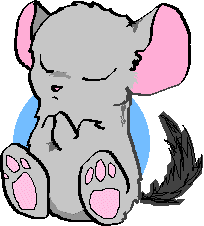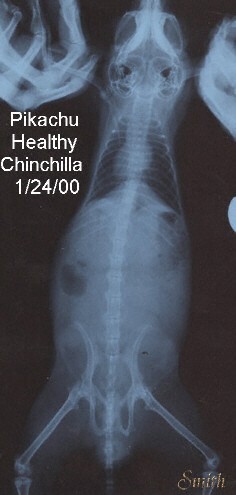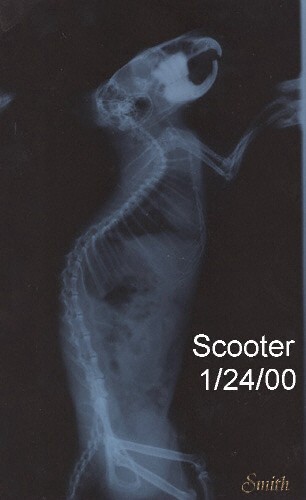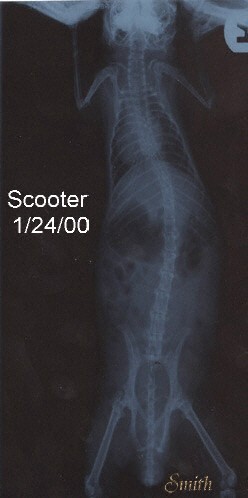

--->This wonderful chinchilla wishes that all chin owners to take good care of the chinchillas and say," Thank You!!!!! Arigato!!!!!!!" Any one who knows people ill-treated chinchilla, please kindly report this to SPCA.
In
order to prevent your chinchilla to fall ill or hurt itself, there are few
golden rules you need to follow:
ō
During the
day, the chinchilla need a good rest. In the presence of continuous daytime
disturbance, it will bring more stress, nervous and frantic.
ō
Sudden
changes in food combinations can lead to diarrhea
ō
Check
the droppings every day. Have the animal seen by a veterinarian at the first
signs of diarrhea or constipation
ō
Regularly
check the animalís nutritional level
ō
Check
the freshness date of chinchilla pellets and hay
ō
Check
that the hay is not damp and moldy
ō
Give
fresh water and clean the water bottle thoroughly
ō
Try
to provide fresh chewing material in the cage on a regular basis; that gives the
chinchilla something to do and a chance to wear down its incisors.
Symptoms:
Milky or watery eyes discharge from the eyes; the area surrounding the affected
eyes is wet and matted; dried discharge looks like cake frosting; eyes swells
shut
Possible
causes: Side effect of systemic illnesses; in addition, grains of sand, dust,
and small injuries can lead to inflammation of mucous membranes.
Treatment:
Take the animal to the veterinarian, who might prescribe an antibiotic salve.
Prevention:
At the appearance of the slightest discharge from the eyes, remove the sand bath
for a week
Eye
Infection
Symptoms: It may also be accompanied by a white matter surrounding the eye or red swollen lids. This infection maybe caused by the dust particle present, reduction in the animal resistance due to improper diet or stress to have an upper hand. Watery eyes (not infectious) may be that the animal is suffering from a cold or pneumonia. The desired room temperature for the chinchilla is between 21 to 28 degrees Celsius. Always check the room temperature instead and if the chin upon touching its ear is warm and having a pinkish or reddish colour. It can also followed by wheezing or breathing difficulties; the animal may be suffering from cold or pneumonia.
Treatment: Giving the animal lots of drinking water and avoid dusting them until it cures can do the treatment for cold. The flip side will be that it might lead to pneumonia and visiting the veterinarian will be the order of the day.
Symptoms:
There will be trembling or cramping, especially in the hind legs; contortions;
temporary inability to move.
Possible
causes: Calcium or vitamin B deficiency; stress, often in the case of pregnant
females.
Treatment:
Take the animal to the veterinarian. In the case of vitamin B, injections have
proven effective. Ask your veterinarian about giving your pet calcium, which
might be effective against cramps. During the day the animal must be carefully
protected from noise.
Prevention:
Ask your veterinarian about giving your chinchilla daily calcium. Provide
disturbance Ė free daytime rest for the animal
Symptoms:
Droppings become increasingly small; sluggishness; loss of appetite.
Possible
causes: Too many treats; improper food; lack of exercise
Treatment:
Substitute raisin for your petís usual treats. Give a tame chinchilla more
exercise in the evening if itís used to running around if its used to running
around. If, in spite of treatment, the droppings keep getting smaller, or if the
chinchilla doesnít recover its appetite, you need to take the animal to a
veterinarian; otherwise, intestinal paralysis can result and quickly lead to the
animalís death.
Prevention:
Never overfeed your animal, and refrain from giving it too many treats. Let your
animals run around free as long as it needs to in order to satisfy its desire
for movement.
Diarrhea
If
the diarrhea is a new condition, you should have your chinchilla checked by a
vet, particularly a vet experienced with guinea pigs and other rodents. Have
your chinchilla's stool checked under the microscope as a wet mount [it must be
fresh] for giardia and coccidia. Have your vet check the teeth (which takes a
lot of finesse), making sure that the molars do not have spurs or points. If
they do, they need to be burred down - a procedure best done under anesthesia.
If your animal has giardia, then ask for Albendozol, not Flagyl. Flagyl only
kills not more than 50% of the parasite and can caused liver failure in
chinchillas. After about 3 days of treatment, Albendozol usually does kill the
bug and no harmful side effects because it is not absorbed into the blood stream
of the chin. It may cause a little loss of appetite for a couple of days, but
this usually passes.
If
that is not the case, you then give the chinchilla some Kaopectate for children
as an alternative. Cherry flavor seems to be most favored by the chins.
Method:
Pour some into a teaspoon, and let your chinchilla lap up as much as it wants.
If one or two doses in one or two days do not cure this, you try some yogurt
with a little Metamucil. Mix about 1/4 teaspoon into an ounce of yogurt and give
to your chin. If this does not help, you must have a longer exam by the vet
including a complete blood count. Often coccidia do not show up under the
microscope but it can cause anemia because it causes hemorrhage.
Hence
you go to a basic diet: strictly pellets and hay only and give him lots of
water. You might want to put some Pedilyte into the water for electrolytes.
Weigh your animal daily. If it is losing weight, then switch to alfalfa and
grind up pellets and some calf manna and mix with baby food (fruits seem best,
oddly enough) into a soft mush and get your animal to eat it.
Weight
loss is dangerous. If your chinchilla weighs below 14 ounces (400 Gm), your
chinchilla is in real danger of failure to thrive and needs to be fed
frequently. Always stay close contact with your vet here
Symptoms:
Soft or runny droppings that stick to the floor or sitting shelves.
Possible
causes: Damp or moldy hay; algae in the green feed; indigestible green plants;
ingestion of harmful substances such as cleaning or washing materials; sudden
change in food; overeating in the case of young animals.
Treatment:
Cease feeding pellets for one to two days; morning and evening feed a quarter of
an old, hard whole wheat roll, and give only again, supplement morning and
evening feedings with a few pellets; gradually increase quantity of hay and
reduce the portion of dry quantity of pellets within a week, and there after
continue to feed as usual. Droppings need to be cleaned from the sitting shelves
everyday and the shelves should be scrubbed with clear water; bedding needs to
be replaced daily. If condition worsened or not getting better, you MUST
immediately bring the animal to the vet. If possible, take the dropping for
detailed analysis
Prevention:
In the feeding, check hay for dampness and presence of mold. Clean the water
bottle and drinking tube regularly. Be sure that young animals donít overeat.
Symptoms:
Eating slowly; exaggerated chewing; slobbering; unnatural growth of the
incisors.
Possible
causes: Congenital defect in teeth; irregular wear on molars; sharp points on
molars; sharp points on molars irritate the tongue or mucous membranes of the
cheeks. When the incisors can no longer be used, they become too long and
interfere with eating.
Treatment:
The sharp points on the molars must be nipped or ground off by a veterinarian
while the animal is under anesthesia; it can also be done to the incisors
(Animals which have faulty molars that can be passed on is advised not be used
for breeding)
Symptoms:
Slower than normal eating; chewed pellets fall from mouth, or the animal cannot
bite properly; increased salivary flow; unnatural position of the incisors;
incisors that are too long.
Possible
causes: Calcium deficiency; too little material to chew on; incisors may have
grown abnormally after being broken in an accident such as a jump from too great
a height.
Treatment:
A veterinarian must take care of defective incisors. Incisors that have grown in
abnormally must be shortened little by little. Continually check nutritional
status whenever an animal has dental problems, ideally by weighing it every week
on a kitchen scale. If the chinchilla continues to lose weight slowly in spite
of all measures and seems to be in distress, you should consider having it
euthanized so it no longer has to suffer.
Prevention:
Give ample calcium supplements; keep providing fresh material to chew on
Hot
and humid weather will result in chins having a common problem known as
"FUNGUS" There are two types of fungus mainly:
1.
One that causes irritation to the skin and causes the fur to drop in patches
exposing the skin, which is red or pink in colour. This fur loss can occur
anywhere where moisture is present.
Symptoms:
Bald spots in coat; crust, scaly skin, scabs, and mange near the nose and around
the eyes; within a few days these patches spread to the head and the forepaws.
Possible
causes: Skin fungi can spread from one animal to another. Purchasing an animal
from unknown stock increases the danger of infection.
Treatment:
A veterinarian must treat fungal skin diseases immediately. It can be done by changing the dust bath and by adding
some foot powder to the new dust bath. Bathing them at least once a week is
generally acceptable but preferably twice a week. The problem should disappear
after several days. Cure may be affected
with pills and additives to the bath sand. A laboratory analysis is necessary if
youíre dealing with a newly acquired animal; itís important to immediately
identify skin fungi that are communicable to humans and other pets
Prevention:
Keep the chinchilla in clean and hygienic surroundings; buy only from a
reputable breeder or established pet store.
Symptom:
Open wounds.
Possible
causes: Bites, tears on nails or sharp corners, contusions from getting caught
in doors or windows.
Immediate
measures: Apply disinfectant to wound. Usually, a chinchilla will not tolerate a
bandage.
Treatment:
The wound must immediately be taken care of by a veterinarian.
Prevention:
Eliminate dangers that may produce injury
Symptoms:
Difficulty in moving, favoring certain limbs, holding limbs in an unnatural
position; in compound fractures, parts of the bones are visible.
Possible
causes: Accidents of any kind.
Immediate
measures: Place the animal in a small, enclosed container and take it to the
veterinarian.
Treatment:
Bring it to the VET!!!!!!!!!
Symptoms:
Extreme emaciation, drooping neck, and stiff back when the animals sits. You can
ascertain progressive emaciation on a kitchen scale: even if the animal is
eating, a weight loss of about .75 ounce to 1.5 ounce (20 to 40g) per week is
cause for alarm.
Possible
causes: Hunchback is a symptom of chronic illness such as illness such as liver
damage or intestinal inflammation due to improper living conditions, especially
improper feeding.
Treatment:
Have the veterinarian determine the cause of the illness. Perhaps the animal can
be helped by modified, proper feeding program.
Prevention:
Prerequisites are proper living conditions and feeding, which can be help
prevent serious illnesses that lead to hunchback. Never give too many treats,
and especially avoid giving the wrong food. Be attentive to the first sign of
digestive disorder.
If
a chinchilla bites own self or another chinchillaís fur, it is a clear
indication that the animal has a behavior disturbance.
Symptoms:
Bald spots in fur; usually the animal cannot be caught in the act of biting.
Possible
causes: Stress due to unaccustomed noises, especially during daytime sleep (for
example, continuous barking of a new dog in the neighborhood, construction
noise, and noisy repairs on the house). Stress from an overcrowded cage; even if
the animals seem to tolerate overcrowding, they need to adequate room. Even
among cage mates tensions can arise that lead to fur biting. Another possible
cause is disturbance of the chinchillaís hormonal balance.
Treatment:
Try to keep the animal free of stress. Consider carefully what changes may have
occurred in the animalís surroundings in recent weeks; new noises, new pets,
or similar problems. You must remove any disturbances that you suspect are
stress factors for the chinchilla.
Prevention:
At the start, you must be certain that any animals that are kept together are
compatible. Provide a large if you intend to breed chinchillas.
Symptoms:
Like a tiger in a cage, a chinchilla runs back and forth on a sitting shelf; at
the end of the shelf, it makes a move to jump down, but instead of jumping, it
resumes its running back and forth.
Possible
causes: The cage is too small for adequate exercise such as running and jumping.
Treatment
and prevention: Place the chinchilla in a large cage with more sitting shelves
and climbing branches; give the animal exercise every evening, and pay attention
to it while itís exercising.

 Both of these X-ray shows a healthy chinchilla
Both of these X-ray shows a healthy chinchilla


Both of these X-ray shows a unhealthy chinchilla
These four pictures will then help you to understand better between a healthy chinchilla and unhealthy chinchilla.
Seizures
To
prevent this you should be sure your pregnant female has extra calcium. I
strongly recommended are calf manna, low sugar soy milk, or calcium blocks by
VitaKraft [Mineral Stone with Seaweed for small animals].
Thiamine
seizures have been described as pre-meal trembling and paralysis, circling and
then seizure activity. The main symptoms are the tremors, staggering, shakes,
twitching types. Treatment is immediate Vitamin B complex.
Toxicity
Trauma
Treatment:
Keep your chin cool with rotating fans (suitable for chins only and do not blow
directly to him), ice cubes or ice pack, air conditioners, dehumidifiers, or
what ever you can. This is not really advisable but if your chin gets too hot,
you may go ahead and immerse up to the neck in moderate to cool [not cold]
water. You may have to blow dry for a while.
The
unknown cause type is
known as epileptiform [epilepsy type] seizures. They are run in
families, so at this time we recommend against breeding a chinchilla with
seizure activity. The problem is electrical activity across the cortex of the
brain which causes rigid posturing and spasms from the feet and mouth. The
chinchilla feels shaky. Sadly, there is no cause and no cure. You may have to
decide if it is better for your animal to put it to sleep.
Seizure-like
activity that is not a seizure:
These are two types:
Pneumonia
One of the easiest ways of checking if your chinchilla has a fever is by simply touching its ears. It is very important to catch this in its early stages, as it could lead to pneumonia. Just as our normal body temperature is the same as the chinchillas'. If the ear feels unusually warm and look a flushed red/pink colour then this is a good indicator. However, due to the way in which chinchillas often sleep - tucking their ears under their body - their ears may feel warm because of this, so wait a little while after your chinchilla has woken up before conducting your examination.
It can also be detected if the chinchilla find it hard to breathe and tends to wheeze or has a runny nose. If this is the case, then your chinchilla will need to see a vet immediately because pneumonia tends to put a great deal of stress and strain on a chinchilla's body, and this could result in the death of the animal.
Enteritis
If either of the two diarrhea symptoms above are suffered for any length of time, it could be due to a problem with the chinchilla's intestine, where the intestinal tract becomes sore and inflamed. This is known as enteritis, and can be the result of an infection, food which has in some way irritated the chinchilla or by the prolonged use of antibiotics and is the result of many different types of bacteria.
Symptoms: Loss of interest in food and special treats, and an inclination to ignore them; difficulty in walking; curling up into a little ball and just staying like that for some time.
If you see this symptoms, please immediately bring it to the vet
Heat Prostration
It is exhaustion or loss of strength due to excessive heat caused by an unsuitable cage location. It will then led your pet to have difficulties in breathing and it will simply lie down on one side and remain motionless. This is very discomfort and stressful for your chinchilla. It is important to take it somewhere cooler and ensure that it drinks plenty of water and, in some instances, its condition may warrant you dipping the chinchilla in a bowl of cool water (remember NOT cold water) up to its neck. This will most probably cool it down.
Hair Ring (ONLY on male chinchilla)
It is a ring of hair which develops around the penis, often due to repeated mating. The animal cannot remover the hair ring himself and so the penis unable to be drawn back into the foreskin. If it is ignored, the penis will waste away and it will cause to have pain. This results in very PAINFUL death..
Symptoms: You will notice that the chinchilla will be very tired and perhaps cannot move or lost interest in eating its food.
Treatment: You will need to remove it yourself by softening it with warm water, using perhaps a gentle lubricant of some kind, and then very carefully and very gently push the penis back into the foreskin. Make sure the chinchilla has no infection or irritation has developed, and that the chinchilla returns to its daily behavior and activities without any further or recurring complications. Any signs of inflammation must be treated by a vet to prevent any disorder.
Isolation
Whenever you are keeping two or more chinchillas together and one or more becomes sick, the sick animal must be kept away for the others. When cleaning the cage, you have to use a completely set of different washing utensils.
If you buy a new chinchilla and wish to house it with other chinchillas you may have already already, it is wise to keep them separated for a period of time, not only to allow them to get used to one another and to reduced the risk of any infectious disease being spread.
Chinchilla
Vet Clinics in Singapore
Pet
Care Centre & Clinic
4 Waringin Park Sin Chuan Garden
Tel: 4485835
Pet
Care Centre & Clinic (Only from 9.30am to 10.30am)
226 Tanjong Katong Rd
Tel: 3467151
Namly
Animal Clinic
74 Namly Place
Tel: 4694744
Animal
Recovery Centre
3 Greendale Ave
Tel: 4637100
*Please do come back here again as this will be updated with more details and latest information
-uploaded at 10/11/2003